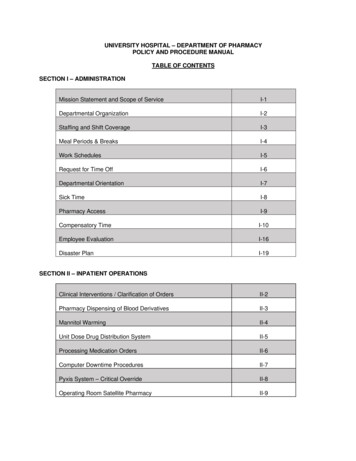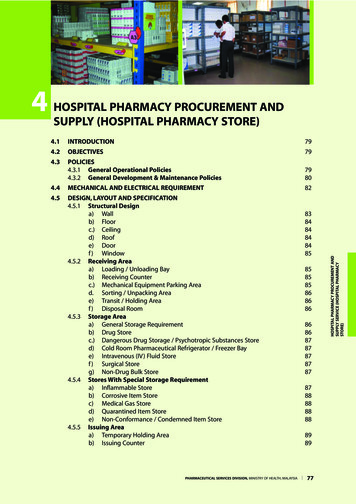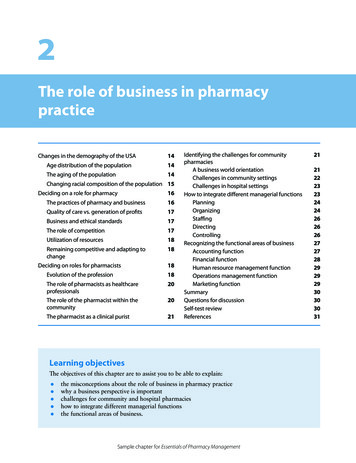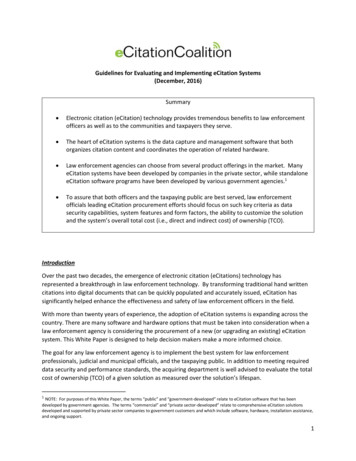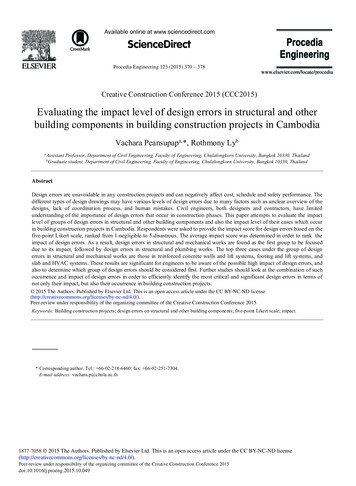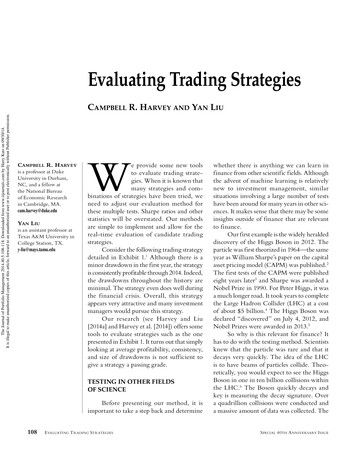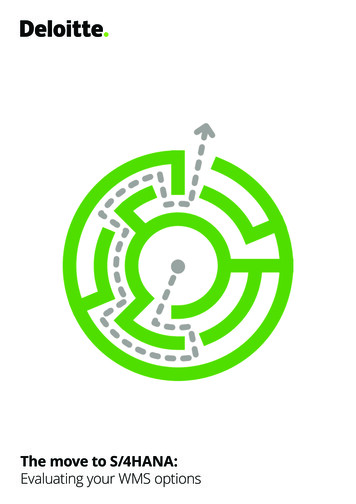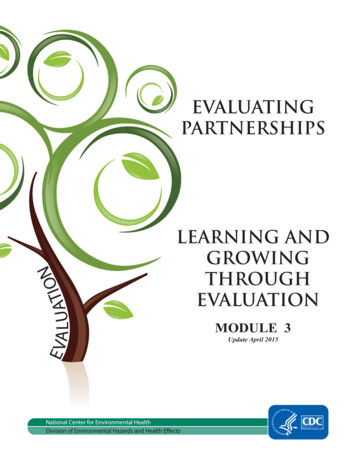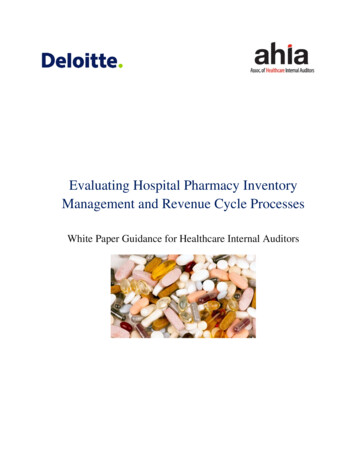
Transcription
Evaluating Hospital Pharmacy InventoryManagement and Revenue Cycle ProcessesWhite Paper Guidance for Healthcare Internal Auditors
IntroductionPharmacy inventory management is a complex but critical process within the healthcare delivery system.Without adequate pharmacy inventory management practices, hospitals run the risk of not being able toprovide patients with the most appropriate medication when it is most needed. Additionally, pharmacies’dispensing patterns and drug selection choices may have a direct effect on the affordability of care.Utilizing drugs that are non-contracted or not on the formulary may be more costly to the patient or mayresult in a lower than expected reimbursement. In addition to patient safety and financial considerations,stringent regulatory requirements pertaining to drug traceability, inventory reporting and inventorymanagement elevate the importance of maintaining effective control over drug inventories in today’s everexpanding healthcare compliance environment.Pharmacies can control a number of factors within the pharmacy inventory management and pharmacyrevenue cycles that can support better outcomes for patients and enhance the bottom line for facilities.This whitepaper provides perspectives on leading practices and internal controls pertaining to:procurement, charge description master maintenance, tracking systems, traceability, storage, disposaland segregation of duties. These control mechanisms can provide a basis for consistent quality, betterfinancial performance and improved regulatory compliance when implemented appropriately and adheredto during day-to-day operations.Drug procurementDrug costs make up an increasing percentage of healthcare expenses. Proper management of drugprocurement is essential for addressing cost and promoting patient safety and quality care. To ensurepharmacy procurement activities are operating appropriately, management should develop formalprocurement procedures to be followed throughout the organization. These procedures should bereviewed regularly and updated as necessary to reflect changes in regulations and operations. Theyshould be designed to promote safety and efficacy for drug purchases, and should include costcontainment techniques, such as: Defining the process for formulary inclusion;Utilizing a limited drug list or the formulary defining each drug to be purchased;Practicing competitive bidding to secure optimal drug pricing;Participating in the 340B Drug Pricing Program when eligible;Taking advantage of greater purchasing power by teaming with industry partners in grouppurchasing (Note: certain restrictions may apply for 340B Program participants) ;Limiting the use of local contracts negotiated outside of the group purchasing organizations; andDefining criteria for selecting drug product manufacturers and suppliers.For ordering controlled substances, hospital pharmacies in the US must register with and abide by therequirements of the US Drug Enforcement Administration (DEA). The DEA categorizes controlledsubstances into five schedules. Schedule II includes controlled substances that are currently used formedical treatment and are considered to have a high potential for abuse, such as oxycodone,hydrocodone, hydromorphine, fentanyl, etc. Hospital pharmacies must order schedule I and II controlledsubstances on an official paper DEA 222 order form or electronically using DEA’s Controlled SubstancesOrdering System The form must be executed or digitally signed by a DEA registrant.1
Data analytics and benchmarking can be used by hospitalpharmacy management to evaluate medication costs relative toindustry standards and to identify drugs that cost the pharmacymore than the expected reimbursement received for their use.Data analytics can also be used to identify drugs with a missing orinvalid National Drug Code (NDC). The National Drug CodeDirectory is available online at the U.S. Food and DrugAdministration’s (FDA) website. Incorrect NDC data can causeinaccurate billing and may negatively impact patient safety. Somefacilities use software to automate the NDC update process inorder to keep NDC data current and reduce errors. Thisautomation can be particularly beneficial during drug shortageswhen suppliers and products may change frequently.In addition to cost management techniques and strong controls around drug procurement, hospitalpharmacy management must properly monitor the processing and payment of drug vendor invoices toensure that products ordered were correctly received and invoiced. Sufficient supporting documentationshould be maintained for pharmacy purchases evidencing drugs received match the type and quantityreflected on the vendor invoice. Data analytics can also be used to compare the price on the vendorinvoices to the negotiated or contracted drug purchase price. Finally, for eligible participants, the 340Bprogram may present significant savings opportunities; however, participation is contingent upon ahospital adhering to strict regulatory standards. Participating hospitals should therefore considerimplementing strong internal controls including, but not limited to, a formalized compliance program.Considerations when conducting an internal audit: Is the formulary appropriate?o Select a sample of new drugs and obtain the applicable Pharmacy and TherapeuticsCommittee meeting minutes to ascertain approval for changes to the formulary.o Analyze the formulary against the NDC for completeness and accuracy.o Analyze drug costs compared to industry standards and expected reimbursement toidentify high cost outliers.How are controlled substances ordered?o Test a sample of controlled substance orders and request the manual DEA 222 form orelectronic documentation. Test system access to procure controlled substances toensure it is limited to licensed pharmacists.Are appropriate approvals in place prior to invoice payment?o Select a sample of drug payments and obtain the associated receipt and invoice support.Verify invoice pricing is aligned to contractual terms. Verify that all transactions wereappropriately approved and payment aligns to goods received and ordered.For 340B Program participants:o Analyze internal controls documented within program policies and operationalprocedures as well as accuracy of program registration documentation.o Test of sample of 340B pharmacy claims to assess whether the product was dispensedto an eligible patient and that the drug was not purchased under a group purchasingcontract. For Medicaid Claims, assess whether claims were appropriately billed.2
Drug receipt and storageDrugs received and stored in a pharmacy can be placed into inventory through a number of avenues.When drugs are received, before placing them into inventory, pharmacy personnel should performappropriate receipt procedures, such as reconciling drugs received to drugs ordered, to ensure thatdiscrepancies between quantity and drug type do not exist. Once the drugs received have been verified,they should be physically maintained in secure storage areas or active dispensing areas of the pharmacy.Drug storage can include the use of automated dispensing devices where drugs are directly scanned andinput into the pharmacy management system according to the type of substance, allowing for automatictracking and inventory counts. Controlled substances require additional storage security to prevent anyunauthorized access and must be received by authorized personnel with a DEA Form 222 (purchaser’scopy) completed and acknowledged by the pharmacist. For storage, pharmacies can utilize narcoticvaults - that remain locked and restrict access within the pharmacy or automated dispensing machines which require controlled substances to be individually placed into secured bins. Both forms of storageshould be restricted through badge access or biometric readers.In instances where drugs are placed and maintained on pharmacyshelves, a typical procedure and leading practice used is called“stock rotation”. Newly purchased drugs with later expiration datesshould be placed behind drugs that are already in inventory. Thispractice may help ensure that expired drugs are not dispensed.Temperature can be an important factor in maintaining and storingdrugs to ensure their quality and integrity. Many drugs (e.g.,chemotherapy drugs) require storage in climate controlledenvironments such as a refrigerator with specific temperatureranges. Reading and understanding drug labels are critical indetermining the storage conditions required. Rather than solelyrelying on wholesaler shipment labels that are placed onpackaging, which may not always be consistent or accurate, pharmacies should be looking at the specificindividual drug labels to understand if any special storage and temperature requirements exist.1Monitoring the temperature of the drug storage area is a critical function to maintain drug integrity.There may be times when drug deliveries are placed ona hospital’s loading dock rather than directly at thepharmacy. In these instances, individuals need to beaware of the temperature control requirements forcertain drugs – that way they can accelerate the processof transporting the drugs from the delivery location to thepharmacy. In addition, if drugs need to be transported toother locations from the pharmacy, monitoring andmaintenance of a controlled temperature environmentmust be ensured. Ideally, these types of drugs shouldbe delivered to the pharmacy which can provideadequate temperature and physical security controls.1Philip E. Johnson, Case Law: When Temperatures Rise, Pharmacists Get cle.aspx?d id 51&a id 34323
Considerations when conducting an internal audit: Are drugs secured and stored appropriately within the pharmacy?o Conduct a physical walkthrough and observe areas within the pharmacy; take note of anyloose/unsecured drugs and assess the storage environment. Ensure controlledsubstances are restricted to appropriate personnel and not accessible to support staff(such as maintenance).What monitoring is conducted over drug storage within the pharmacy?o Understand processes for monitoring temperature of drug storage areas. Test a selectionof temperature controlled drugs to assess whether storage conditions are adequate toprevent spoilage and maintain efficacy.Drug tracking and inventory managementMany organizations utilize pharmacy management systems as a means of ensuring appropriateaccountability over pharmaceuticals and ensuring the traceability of inventory from purchase throughadministration to the patient or disposal. Effective and transparent tracking systems that allow pharmaciesto accurately record inventory components, such as medication expiration dates and physical quantities,also have the potential to reduce adverse patient outcomes. In a national survey performed by theInstitute for Safe Medication Practices, 20% of practitioners surveyed reported that adverse patientoutcomes occurred because of a lack of inventory management and monitoring of supply levels.2Pharmacy management systems, which provide real-time inventory quantities, can assist in maintainingthe balance between stocking appropriate quantities to satisfy patient requirements and minimizingexcess inventory.The “real-time” tracking ability offered through these systems includes recommending items andquantities to be ordered based on par levels set by the pharmacy in the system, providing limits onexcessive orders, and electronically placing orders after a manual authorization. When setting the parlevels for the automated ordering, it is important to set appropriate levels to maximize the orderingprocess and minimize excessive supplies.An additional benefit of tracking systems is more effective management for adding, updating, andremoving inventory as well as the ability to restrict certain functions to responsible personnel (e.g.,dispensing certain types of drugs restricted to certain pharmacists). There are also enhanced reportingcapabilities that serve as a benefit, not only for inventory ordering and replenishment, but also forregulatory compliance tracking and monitoring. These tracking systems are often capable of flaggingdiscrepancies, such as potential concerns, safety risks, and compliance risks, based on predefined rulesets.Not only do inventory controls need to be considered in pharmacy management systems but logicalsecurity is paramount to ensuring the effective operation of those controls. Systems should be restrictedthrough a user name and password or biometric login. Roles within the system should be designed on therule of least privilege and take into consideration both process and regulatory requirements in restrictingaccess. System administrators for any pharmacy system should be limited to a few individuals with anoperational / critical need to access the drugs. Finally, access management controls should be in place to2Lindsay O’Brien, Improving Supply Chain Efficiencies in the Safety Net: An Inventory Management Pilot Program for Free andCharitable Clinics, /images/Vecna%20Cares%20Overview%203%2015.pdf4
ensure changes to a job function or employment termination are reflected with timely and appropriatechanges in user access to pharmacy systems.Considerations when conducting an internal audit: What drug tracking system is utilized and how?o Assess the current drug tracking method and determine if par levels are used and areappropriate.o Assess the process for managing and monitoring par levels.Are discrepancy reports reviewed and investigated on a consistent basis?o Select a sample of discrepancy reports to analyze. Test whether the discrepancies wereacceptable and whether they were reviewed, investigated and resolved.Who has access to the drug systems and is the access authorized?o Test system access by reviewing all current users to determine if their access
Pharmacy inventory management is a complex but critical process within the healthcare delivery system. Without adequate pharmacy inventory management practices, hospitals run the risk of not being able to provide patients with the most appropriate medication when it is most needed. Additionally, pharmacies’ dispensing patterns and drug selection choices may have a direct effect on the .


